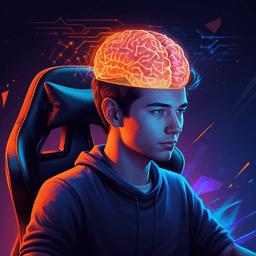
Psychology
How short video addiction affects risk decision-making behavior in college students based on fNIRS technology
S. Zhang and S. Li
Short video addiction alters risky decision-making: research conducted by Shu Zhang and Shiyi Li used fNIRS and the Balloon Analogue Risk Task to show that addicted individuals take greater risks, react faster, and display heightened right OFC and FPA activation—especially when exposed to short video cues and losses—offering neural insights for healthier consumption and therapy.
~3 min • Beginner • English
Introduction
The study examines how short video addiction influences risky decision-making among college students. Short videos, driven by algorithmic recommendations and immediate gratification, have proliferated (e.g., TikTok/Douyin), with heavy use linked to mental health issues, academic impacts, attention deficits, and compromised decision-making. Decision-making involves evaluating gains, losses, and probabilities, and addictions often impair prefrontal functions underlying risk assessment and inhibitory control. The research addresses three objectives: (1) whether short video addiction relates to altered risk decision-making behavior; (2) whether gain versus loss outcomes differentially affect decision-making in individuals with SVA; and (3) how short video-related background cues modulate risky decisions. The study uses a modified BART and fNIRS to capture behavioral and neural responses, focusing on prefrontal regions (DLPFC, OFC, FPA). Three hypotheses were proposed: heightened prefrontal activity under short video cues in SVA; stronger risk appetite under loss versus gain in SVA; and greater cue-induced risk preference in SVA compared to controls.
Literature Review
Prior work shows that addictive behaviors (substance and behavioral) alter decision-making and inhibitory control, often increasing risk preference under uncertainty. Smartphone and gaming addictions have been linked to impaired decision-making and heightened impulsivity, with prefrontal dysfunction implicated. Cue reactivity literature indicates that addiction-related cues (visual/auditory) can activate reward circuitry (e.g., anterior cingulate, insula, prefrontal areas), increase craving, and affect attention and inhibition. Loss versus gain processing is asymmetric; losses can provoke impulsive, loss-chasing behaviors in addictions. Short video platforms provide potent cues via personalized algorithms, diverse formats, and frequent rewards, potentially reinforcing addictive engagement and altering risk perceptions. However, specific effects of short video addiction on risky decisions, and the roles of gain/loss and background cues, remain underexplored.
Methodology
Design: Mixed 2 (group: addiction vs. control; between) × 2 (outcome: gain vs. loss; within) × 2 (short video background cue: cue vs. no cue; within). Dependent variables: number of balloon explosions (NUM), reaction time (RT) per trial, and prefrontal brain activation (fNIRS β values/Δ[HbO]). Participants: Initial campus screening of 240 students using the abbreviated College Students' Short Video Addiction Scale (22 items; reliability α=0.91 overall; dimensions α=0.76–0.89). After removing 19 invalid responses, 221 valid records remained. From these, 45 college students were recruited: SVA group (top 27% scorers; n=23; age 19.6±1.56; 11 males/12 females) and control group (bottom 27% scorers; n=22; age 19.7±0.93; 5 males/17 females). All right-handed with normal hearing; exclusions included psychiatric history, head trauma, epilepsy, severe physical illness, alcohol/drug dependence. Informed consent obtained; ethics approved by Qilu Normal University. Task and stimuli: Modified BART with 30 virtual balloons per block. Each trial: press J to pump (reward increases by 0.1 RMB per pump) or F to cash out; explosion probability increases with pumps; explosion breakpoint random and undisclosed. Block 1: no background images. Block 2: short video-related pictures (selected from 50 images; 30 with association score >3.5 by 80 raters) presented for 1,000 ms before each balloon and as background during pumping. Stimulus presentation via E-Prime 3.0 on 1920×1080 monitor. Real monetary rewards provided. fNIRS acquisition: Portable Huichuang device with 12 sources and 12 detectors forming 34 channels over PFC (ROIs: bilateral DLPFC, OFC, FPA). Channel locations aligned to MNI coordinates; specific Brodmann areas mapped (e.g., BA9/46 for DLPFC, BA10 for FPA, BA11/47 for OFC). Procedure: Two-stage study (scale classification; experiment). fNIRS data collection during task; a 3-minute resting baseline included. Preprocessing: wavelet-based motion artifact removal; band-pass filter 0.01–0.2 Hz; convert optical density to Δ[HbO]/Δ[HbR] via modified Beer–Lambert law; Δ[HbO] used for analysis due to higher SNR. Modeling and statistics: GLM to estimate task-related β values per condition/channel; block averaging; 2×2×2 repeated-measures ANOVAs on β values (SPSS 20.0), Greenhouse–Geisser correction for sphericity, Bonferroni for multiple comparisons within factors, and FDR correction across channels. Behavioral outcomes analyzed with the same 2×2×2 ANOVA on RT and NUM.
Key Findings
Behavioral: • Reaction time (RT): Significant main effect of outcome: F(1,42)=46.866, p<0.01, partial η²=0.533; RT shorter for loss (5827.240±372.842 ms) vs. gain (6905.498±430.416 ms). No significant group differences. • Balloon explosions (NUM): Significant main effect of short video background cue: F(1,42)=8.514, p<0.01, partial η²=0.172; more explosions with cues (10.136±0.550) vs. no cues (8.398±0.569). No significant interactions otherwise at behavioral level. Neural (fNIRS Δ[HbO] β values): • Main effect of outcome: Multiple channels (2,4,6,7,10,20,21,22,29,30,31,32,33) showed higher activation for loss vs. gain across OFC, FPA, and DLPFC (e.g., CH2 BA10: F=12.884, p_FDR=0.001, η²=0.231; CH6 BA11: F=12.672, p_FDR=0.001, η²=0.228; CH33 BA9: F=11.251, p_FDR=0.002, η²=0.207). • Group × cue interaction: CH3 (F(1,43)=4.791, p=0.034, η²=0.100) and CH4 (F(1,43)=5.965, p=0.019, η²=0.122), both mapping to FPA, showed greater activation in SVA vs. controls under short video cues (simple effects: CH3 F=5.560, p=0.023, η²=0.144; CH4 F=4.601, p=0.038, η²=0.097); no group difference without cues. • Group × outcome interaction: CH2 (right FPA) F(1,43)=4.680, p=0.036, η²=0.098; in SVA, right FPA more sensitive to loss (0.022±0.014) vs. gain (−0.035±0.009), F=16.923, p<0.001, η²=0.282; no difference in controls. • Group × outcome × cue interaction: CH17 (FPA) F(1,43)=4.195, p=0.047, η²=0.089; under cue+loss, SVA showed higher HbO (0.004±0.008) than controls (−0.018±0.008), F=3.789, p=0.048, η²=0.081. CH30 (left DLPFC) F(1,43)=4.134, p=0.048, η²=0.088; in SVA under cue condition, loss (0.001±0.006) > gain (−0.017±0.006), F=7.074, p=0.011, η²=0.141. No significant differences without cues. • Brain–behavior correlations: In SVA, under loss with cues, activation across ROIs correlated positively with number of explosions (p<0.05), indicating that greater FPA/DLPFC/OFC activation aligned with higher risk-taking. Under no-cue conditions, only left OFC activation correlated with explosions; other conditions showed no correlation.
Discussion
Findings support the hypotheses that short video cues and loss contexts modulate risky decision-making and prefrontal activation in individuals with short video addiction. Behaviorally, cues increased risk-taking (more explosions) and reduced deliberation (shorter RTs), indicating cue-driven impulsivity or altered risk perception. Neurally, SVA participants showed cue-specific hyperactivation in right OFC and FPA, consistent with elevated reward valuation, attentional bias, and prospective processing toward short video stimuli. Loss contexts elicited stronger responses than gains across OFC, FPA, and DLPFC, with SVA exhibiting pronounced sensitivity to negative outcomes, possibly reflecting intensified punishment processing or discrepancy between expected rewards and realized losses. The three-way interactions (cue×loss in SVA) in FPA and left DLPFC suggest heightened engagement of cognitive control and integrative prospective mechanisms when confronting losses under salient short video cues, aligning with compensatory efforts to regulate impulses amid elevated temptation. Positive correlations between activation and risk-taking under cue+loss conditions indicate that neural hyper-responsivity accompanies and may facilitate risky choices, highlighting vulnerability to environmental cue influences in SVA. Collectively, results elucidate how short video-related stimuli interact with outcome valence to shape decision-making and prefrontal dynamics in behavioral addiction.
Conclusion
The study demonstrates that college students with short video addiction are more susceptible to short video-related cues, more sensitive to losses, and more inclined to pursue higher rewards, resulting in higher-risk decisions. fNIRS revealed distinct prefrontal activation patterns (OFC, FPA, DLPFC) in SVA, particularly under cue and loss conditions, advancing understanding of neural mechanisms in technology-related behavioral addiction. These insights can inform clinical interventions (e.g., targeting cue reactivity and loss sensitivity), platform design (e.g., moderating algorithmic prompts and notification frequencies), and public health policies (e.g., usage time limits) to mitigate adverse decision-making impacts. Future work should refine diagnostics and personalized interventions leveraging identified neural markers and explore cross-age generalizability.
Limitations
The study is correlational and does not establish causality between neural hyperactivation and addiction or risky behavior. Short video cues may not capture the full diversity and complexity of platform content and visual effects, limiting ecological validity. fNIRS coverage focused on frontal regions and cannot assess deeper structures (e.g., ACC), constraining mechanistic inferences; multimodal imaging (fMRI, EEG, MEG) is recommended to overcome temporal/spatial limitations. The sample comprises college students; findings may not generalize to other age groups (children, adolescents, older adults). Future research should diversify participants, examine varied short video content types, and integrate multimodal neuroimaging to better characterize addiction mechanisms across populations.
Related Publications
Explore these studies to deepen your understanding of the subject.







